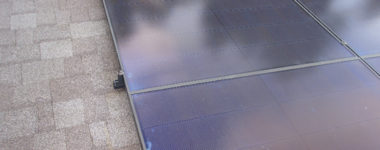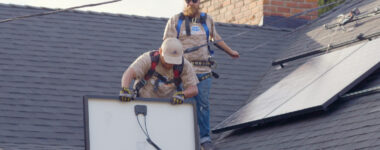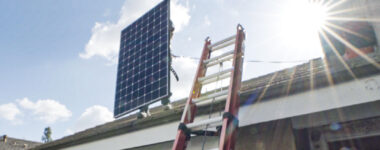Solar Panels San Diego | Solar Panels, Battery Storage, Roofing, HVAC
Does Going Solar Make Sense In San Diego? The San Diego region is blessed with an abundance of sunlight, making it an ideal location for solar power. Solar panels installed in San Diego can generate enough electricity to power a home or business, and the region's climate means that panels will typically experience little wear and tear. Reasons To Go Solar San Diego If you're considering solar power for your home or business, San Diego is a great place to do it. Solar power is generated by converting sunlight into electricity. Solar panels are made up of many solar cells, and when sunlight hits these cells, it knocks electrons loose. These loose electrons flow through the material to create an electric current. This current can then be harnessed and used to power homes and businesses. Solar power is a renewable, clean, and efficient source of energy, making it a smart choice for San Diego residents. With an average of 260 sunny days per year, San Diego has the potential to generate a significant amount of solar power. Solar panels require little maintenance and have a long lifespan, making them a cost-effective investment. Making the switch to solar power can help reduce your carbon footprint and support the move towards a more sustainable future. Solar Panel Installations San Diego Overall, solar power is a great choice for San Diego residents. With plenty of sun and little wear and tear on the panels, solar power can save you money in the long run. Plus, it's good for the environment!
With 266 days of sun per year, San Diego is a prime candidate to become the leader in solar power. After all, the average number of sunny days is just 205 across the country. We nearly have the type of sun that towns on the east coast could only dream of. You can add to the city’s growth as a green community by putting solar panels on your own home. From Mission Beach to Alpine and Chula Vista to Carlsbad, San Diego County homes are in a great position to make their own energy using the power of the sun. Even better, solar energy is contagious. If you put solar panels on your own home, your neighbors are more likely to consider becoming energy independent, too. Before you know it, San Diego will be totally powered by the sun. Getting It Right with Solar Panels in San Diego If you’re new to the idea of solar power it’s easy to get overwhelmed. How many panels do you need? When is the best time to get them installed? Will you recover the costs of the solar panels when you sell your home? Before you make any decisions, let’s take a look at some of the basic do’s and don’ts of going solar in Sunny San Diego: Do: Consider Getting Panels Installed in the Off-Season Solar professionals have a busy season and an off-season, just like any business. It’s no surprise that the summer months get people thinking about going solar. Air Conditioning means escalating utility bills and the ever-present sunshine is top of mind. If you want to go solar in San Diego, consider getting your panels installed during the off-peak season. Not only can you get better discounts if you get solar installed during the off-season, but you’ll get more attention from your solar installers. A slower schedule for solar companies means they can spend more time walking you through the process and devoting extra energy (no pun intended) to your job. Don’t: Rush to Get Your Panels Installed Before the First Heat Wave You see the summer season approaching and you know the peak season will arrive with it. Better get those panels installed right away… right? Not so fast. Rushing to get your panels installed could present its own problems. For one, you should get your roof assessed before you install solar panels. Like all types of roofing materials, the Spanish tiles popular in Southern California have a limited lifespan. It would be a shame to install solar on a failing roof that needs to be replaced soon. Give yourself a few months for inspection and repairs instead of rushing to get panels installed before the first big heatwave, even if your favorite installer can fit you in. Overall, winter is the best time to make an appointment for solar installation. Do: Examine Which Direction Your Roof Faces to Maximize Panel Access to the Sun The ideal way to place solar panels is facing south. You can also point your solar panels to the east or west, though they will produce about 20 percent less energy. If you only have the option to place your panels on a roof that faces north, you may want to consider installing panels on the ground or using a creative tilting system. The way your solar panels face may have a big effect on the type of panels you choose and the number of panels you need. Planning ahead is key. For instance, you may learn that while your roof faces south, there may be a shadow cast on it for a good amount of the day. Most situations can be altered to make solar work but being aware of your roof’s relationship with the sun is the first step to developing a plan. Don’t: Assume Sea Fog or Tall Palms Mean You Won’t Get Enough Sun It’s true that solar panels work at maximum efficiency when they get regular direct sunlight. If you live in Ocean Beach, you might worry that the frequent ocean fog means your panels will be starved of sufficient UV rays. The good news is that even under fog, solar panels can absorb about half of what they need to operate at full potential. When the fog burns off at about noon, your panels are fully back in business. Likewise, tall trees that provide tons of shade to your roof can be a problem, but they don’t rule out solar panels. Trimming fronds and tilting the panels can mean your trees and solar panels live in harmony. Do: Look for Rebates to Enjoy More Cost Savings Your solar installer may offer great discounts during the off-peak season, but that’s not the only way to save cash on your panels. While the San Diego Gas and Electric (SDGE) solar rebates are currently exhausted for San Diego residents, the solar thermal rebate program is still active and has a total of $28 million to hand out. Keep your eyes peeled for other city or state rebate programs that will cut back on your initial costs. SDGE has a helpful guide that explains the various ways you can leverage various types of savings for solar installation. With the California push toward solar (most new builds will be required to have panels as of 2020), it’s always possible that new rebates could become available for current homeowners in San Diego. Don’t: Give Up on Solar If You Don’t Qualify for State Discounts If you don’t have access to city or state rebates, all hope for major savings is not lost. You can still apply the federal tax credit for solar investment (ITC) to your taxes next year. The tax rebate allows you to deduct up to 30% of the cost of your PV panel installation. You should also consider the annual savings from switching away from the grid and the increased value of your home. Even if you don’t save money in a lump sum rebate upfront, you still stand to make a lot of money in the future. SDGE will also compensate you for the excess energy generation that you give back to the grid if you apply and are approved for the NEM program. Do: Work with a Local Solar Company That Understands San Diego Climate A company that knows San Diego weather and climate patterns will be able to explain exactly what financial returns you can expect from going solar, and how many panels you need to fully power your home. Only a company that knows the entire county will know the needs of homes in Mission Valley versus a property near the coastal fog at the beach. In addition to considering price, it’s wise to place value on how well the solar company understands the needs of a San Diego homeowner. Is it be worth it to pay less if you work with a company that only has a history of working in the desert? Don’t: Be Shy About Vetting Your Solar Company Thoroughly You have the right to ask as many questions as you want of any solar company. After all, going solar is not only a big financial investment: it’s also a change in lifestyle. You want to work with an organization that knows the solar industry and is comfortable being asked about their practices, costs, and knowledge of San Diego installations. So, are you ready to get serious about going solar in San Diego? You won’t be left wanting for sunny days to shower your new panels with energy. Between the increased value in your home and the ability to become energy independent, getting solar panels in San Diego has too many benefits to pass up. Contact Semper Solaris today to find out more about going green in San Diego.
It’s easy to feel overwhelmed with the onslaught of alarming climate news. The polar ice caps are melting. Hurricanes and rising oceans are swallowing islands. Wildfires in California are getting bigger and badder. Oh, and what the heck is happening to all the bees? It’s enough to make you grab a tub of ice cream and hide under the bed. Before you give up all hope, remember the power of human ingenuity. Small actions from a lot of people can add up. Earth Day is almost here, and with it comes a reminder that you can fight the effects of climate change by making smarter environmental decisions in your life. That might mean something as big as investing in California solar systems, or something as small as using fewer water bottles this year. Every action matters. In honor of Earth Day on Sunday, April 22nd, here are five things you can do to lower your carbon footprint and fight for our beautiful planet and home. Install California Solar Systems Of course we would start with this one! Here at Semper Solaris, we help homeowners lower their carbon footprint every day by installing solar power systems on their homes and businesses. San Diego is one of the best cities in the country to go solar, thanks to our abundant sunshine and progressive utility companies that offer net metering. The average family used 10,766 kilowatt-hours (kWh) in 2016. According to the Carbon Fund, one kWh equals roughly 1.22 pounds of CO2. Families that invest in California solar systems that cover their entire energy usage could save over 13,000 pounds of CO2 from hitting the atmosphere each year. That’s a big deal! Buy an Electric Vehicle Unless you live in downtown San Diego or a beach community like Pacific Beach or Solana Beach, chances are that you need a car to get around. Each commute to work, grocery store run, or doctor’s appointment emits CO2. In fact, the typical passenger car spews out 4.7 metric tons of carbon dioxide a year! If you have a long commute and/or drive a vehicle with poor gas mileage, your carbon bill will be even higher. Don’t want to feel guilty for that midnight In-N-Out Burger run? Ease your conscience with your next car purchase and consider an electric car. These days, there are plenty of models on the market, from the sleek Tesla Model S to the mid-range Chevy Bolt and Ford Focus Electric. The Mitsubishi i-MiEV or the Smart Fortwo are perfect options for the driver on a budget. While electric cars tend to be more expensive than their gas-guzzling peers, you can nab federal tax credits for purchasing one of these cars. Additionally, with a little planning, your solar power system can cover the extra electricity your new set of wheels needs! Plan a Staycation You and your family deserve an awesome vacation each year, but flying is one of the most carbon-expensive actions you can take. A trip from San Francisco to New York will produce almost a metric of CO2 per passenger, which represents roughly 20% of all the greenhouse gases your car produces in a year. Does that mean vacation is canceled this year? No way! Instead, consider keeping your vacation a little closer to home. After all, you already live in one of the best vacation destinations in the world. In California, you can create almost any type of vacation you want. Walk down Hollywood Boulevard, take the kiddos to Disneyland, visit Alcatraz, lounge on a pristine beach, or shred it on the slopes. Here’s another staycation idea: while you’re doing your part to save the planet, why not remind yourself of what you’re protecting? California is home to 28 National Parks, including: Yosemite National Park Redwood National Park Joshua Tree National Park Death Valley National Park Sequoia National Park and a whole lot more! Reduce, Reuse, Recycle Maybe you’re not ready to invest in solar panels in San Diego or pick out a new car just yet. Lowering your carbon footprint doesn’t have to be an expensive endeavor or even that lifechanging. It can be as simple as reworking your current habits just a little here and there. What are some of the things you can reduce in your life? How about plastic water bottles and paper towels? Think about whether you can save water and electricity by waiting until the washer or dishwasher is full before running a cycle. It’s difficult to determine the environmental impact of every single product, but the Carbon Fund estimates that every pound of manufactured product costs 4 – 8 pounds of CO2. Think about that the next time you stop into your local big box retailer. Before each purchase, ask yourself, “Will this make my life better?” If not, then maybe you don’t really need a 50th pair of shoes or another magazine. When it comes to recycling, it really doesn’t take a lot of effort to toss your paper, glass, aluminum and recyclable plastics into the recycling bin. If you really want to step up your game, see if any local farmers in your area are accepting organic waste for composting. There are other ways to recycle. Give old clothes and things you don’t use anymore to Goodwill or the Salvation Army. Someone else can use it, which means they won’t have to buy something new! Carbon Offsets Living a more environmentally focused life doesn’t mean you have to give up every pleasure. Most human activity generates carbon in some form. It can be easy to start feeling guilty about every trip to the grocery store, every pack of new socks, or the flight you had to take for a business trip. Guilt and fear lead to resentment and feelings of depravation. That’s not what Earth Day is about, and it’s not a great way to live your life. Instead, give yourself permission to find a balance between eco-consciousness and fulfillment. One way to do this is to purchase carbon offsets to help balance out the ways you add carbon to the environment. You’d be surprised at how affordable offsets can be. A flight from San Francisco to New York will cost less than $11 in offsets through United’s offset program. Be careful when choosing a carbon offset company. Make sure your company is verified by an independent third party to ensure that it’s using your money in a way that really takes carbon out of the atmosphere (like planting trees) or prevents carbon pollution (like donating to a wind farm). Not sure which carbon offset company to choose? The Sierra Club recommends NativeEnergy. Carbon Reduction Lighting Round Thought we were done with the carbon reduction recommendations? Not so fast! A lot of the suggestions we’ve made require big changes to your life, but even small changes can have a big impact if you keep at them over the years and convince your friends and family to join you. Here are 10 quick, easy, and cheap ways to reduce your carbon footprint that you can easily turn into automatic habits: Unplug chargers and switch off power strips when they aren’t in use Lower your thermostat one degree in the winter and increase your thermostat by one degree in the summer Keep your tires inflated Make one day “meatless” per week Order chicken instead of steak Group errands together so you don’t take as many solo car trips Carpool to work Make a commitment to walk if your destination is less than a mile away Don’t speed Use a traffic app to avoid congested roads Celebrate Earth Day Earth Day is a chance to celebrate our potential. We’ve gotten ourselves into this climate change problem, and we can get ourselves out as well. This will require human ingenuity, passionate advocacy, and changes in how we live on a global and personal scale. At Semper Solaris, we are a veteran-owned solar installation company proud to be fighting this new battle. Solar panels help our customers save money and reduce their carbon footprint. If you live in San Diego, we hope you’ll celebrate Earth Day with us and consider scheduling a free energy analysis.
With abundant sunshine and the Pacific Ocean in its back yard, San Diego has always been an eco-friendly, forward-thinking place. That’s why it leads the U.S. in solar energy installments. In fact, going solar in San Diego is a common theme for America’s Finest City and its residents. The county increased its solar capacity 60 percent in the past year to 303 megawatts. If you’re looking to live in sunny San Diego (or even if you already call it home), here are the top neighborhoods to go solar based on key factors that add to the overall quality of living. 1. Del Mar The coastal city of Del Mar (Spanish for “by the sea”), takes the number one spot for the top neighborhood in San Diego County. It’s ritzy, yet laid back beach-town vibe makes it a pleasant place to live for many residents. Just about 30 minutes north of downtown San Diego, the area is home to many families and its public school system receives an A+ rating, ranking the #4 suburb with the best schools in the state of California. When it comes to fun activities, Del Mar is famously known for being home to the historic Del Mar Racetrack, where horse races take place all summer long and the town is also one of the only places where Torrey Pines, the rarest pine tree in the United States, grow. Hike, surf, bet on the ponies or just enjoy a stroll in the sunshine - Del Mar boasts breathtaking views around every turn and excellent beach-front weather, making it a go to place to install solar panels in San Diego. 2. Solana Beach The apple doesn’t fall far from the tree, as Solana beach, the neighboring town of Del Mar, ranks second as a top neighborhood for solar in San Diego. Solana Beach has a population of 13,000 and is known for its beach, eclectic shops, dining, nightlife, golf courses and hiking scene. It averages a comfortable 62 degrees during the winter season and 77 degrees during the summer time, with a near two-mile stretch of coastline to enjoy. Locals frequent Fletcher Cove Park, a favorite spot to catch beautiful sunsets. Commuter-friendly Solana Beach houses a major train station stop (one of only three in San Diego County) that serves both Amtrak and the Coaster and residents have easy access to San Diego’s major freeways, including the 5 and the 101 interstate highways. With its outdoor-friendly sentiment, this town upholds environmental consciousness, making it a chief contributor to a more solar San Diego. 3. Encinitas Moving further up the cost, the town of Encinitas is another top pick for places to go solar in San Diego. Encinitas was named among the 20 best surf towns in the world by National Geographic and sits along the historic coastal Highway 101. It’s home to 62,000 residents and is segmented into five different areas: Old Encinitas, New Encinitas, Olivenhain, Leucadia and Cardiff-by-the-Sea. Each of these communities has its own personality offering a range between an oceanfront beach life to more rural, family-oriented suburbia. Old Encinitas sits along the coast and is known for its famous surf break, Swamis. In Olivenhain, you can find private equestrian facilities and mainly single family homes. New Encinitas boasts numerous golf courses and shopping centers, while Leucadia is a place of tree-lined streets, art galleries and eclectic stores. Cardiff-by-the-Sea is an oceanfront community and home to the San Elijo Campus of Mira Costa College. Encinitas has something for everyone, which makes it extra appealing to live and reap the benefits of solar year round! 4. Coronado Just south of downtown San Diego, across the signature Coronado bridge is an island called Coronado. The island community is a top tourist attraction because of its famous Hotel Del Coronado, where Marilyn Monroe used to frequent. But aside from being a major San Diego destination for visitors, it’s also a very family-friendly place to live. Coronado has a small-town charm to it, with shops, art galleries, restaurants and theatres for its residents to enjoy. And don’t think the beach is just any old beach. Its signature gold sand makes it extra beautiful and mesmerizing as the year round sun reflects off the golden flecks floating in the ocean. The town is also home to a U.S. Naval Base, which instills an all-American pride in Coronado locals. Those who reside here get to enjoy views across the water of San Diego Bay and the downtown skyline as they bask in their private escape that is Coronado. Living in Coronado, however, comes at a price. The median home value is $1,332,500 while average rent is $2,268 per month. These higher end costs make solar power even more appealing as it saves residents money in their electricity bills, making Coronado a big proponent of solar San Diego. 5. Carlsbad Carlsbad is a large suburb in North County San Diego. Its population of 112,000 includes many families and the city is one of the most affluent in the state of California. It’s filled with seven miles of beaches, nature trails and endless family attractions, including Legoland. Carlsbad divides into four different quadrants, each with its own distinct attractions. The northwest quadrant encompasses the “Village” (downtown) and Old Carlsbad— the first part of Carlsbad to be settled. Houses here include everything from cottages and bungalows to mansions overlooking the ocean. The northeast quadrant of Carlsbad consists of mainly single-family homes while the southeast quadrant has a handful of master-planned communities along the hillsides, golf courses and parks. The southwest quadrant stretches along the Pacific Ocean, where constant sunshine makes it solar energy friendly. The top neighborhoods for solar in San Diego all have a common thread—the residents appreciate the environment they live in and take advantage of their ideal setting in the sun. With the ocean and beaches in close vicinity, there’s an extra amount of respect to keep the place they live in clean—and solar energy is a part of that. As the sun keeps shining, these communities will continue to keep San Diego #1 in solar installation. If you live in one of the communities (or anywhere in San Diego) and don’t already have solar panels on your home, we’d be happy to give you a free energy analysis so that you can see how to start taking advantage of the year-round sunshine we have in Southern California!



